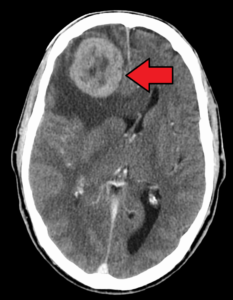Ever wonder how long a person can have a brain tumor before it’s finally diagnosed?
Just how long can a tumor sit in one’s skull before it’s finally discovered?
“Brain tumors are abnormal growths inside the skull,” says Sumeer Sathi, MD, a neurosurgeon with NYU Langone Health, who treats brain tumors.
“They can be further classified as benign (noncancerous) versus malignant (cancerous).”
Many brain tumors are secondary, that is, a metastasis from a primary cancer elsewhere in the body, such as breast or testicular cancer.
Symptoms of brain tumors that many people are already knowledgeable of include headache, loss of balance or clumsiness, vision problems, change in personality, confusion and seizure.
Symptoms that most people would never think could be caused by a brain tumor include loss of appetite, a drooping eyelid, tingling in an arm and a bulging eye.
Detection of Brain Tumors

James Heilman, MD httpscommons.wikimedia.org
“These tumors are usually detected once they begin to cause symptoms,” says Dr. Sathi.
Delays, however, often occur and for a variety of reasons.
For instance, if someone’s having loss of appetite and nausea, they might first see a gastroenterologist, thinking the source is in their gut.
Another example is if a very young child has symptoms but is not old enough to describe them, or the parent dismisses the symptoms as normal preschool behavior such as stumbling here and there, or sudden development of very picky eating (both of which can be caused by a brain tumor!).
Dr. Sathi continues, “However, some brain tumors can go undetected indefinitely and may only be detected incidentally.”
So believe it or not, a person can be going about his daily life as always – for years – then get into a car accident.
At the ER, with head trauma and signs of a concussion, he undergoes a CT scan – where a tumor is found in his brain. It could’ve been there for years.
“Many small brain tumors that are generally benign — such as nerve sheath tumors along other cranial nerves such as in neurofibromatosis, pituitary adenomas, meningiomas — may not be diagnosed unless they become symptomatic or as incidental findings,” explains Dr. Sathi.
An example is an acoustic neuroma, also known as a vestibular Schwannoma, which begins in the inner ear canal.
This benign mass is very slow growing and often asymptomatic due to a small size – but can easily be discovered when the patient undergoes imaging for an unrelated reason.
The treatment is regular surveillance to monitor growth and new symptom development (sudden hearing loss in one ear, ringing in that ear).
A meningioma is benign and, if it’s not causing symptoms but is accidentally found, there will be no reason to remove it (as with the acoustic neuroma), and instead, it’ll be surveilled.
However, a meningioma, depending on its location, can eventually grow larger and begin causing serious symptoms (e.g., double vision, seizures, weakness) and need to be removed and also treated with targeted radiation.
But because it’s benign, it can’t spread to other parts of the body.
“Larger tumors, especially meningiomas or lower grade gliomas or other primary tumors, can grow to be very large in non-eloquent brain tissue without causing symptoms or subtle personality changes until they cause severe pressure or seizures.
“Generally, benign tumors can remain undetected for years and sometimes are seen as incidental findings on MRI or autopsy.”
A brain tumor will not go unnoticed for long once it starts causing symptoms.
 Dr. Sathi’s expertise includes spine surgery and treating brain tumors including metastasis, gliomas, meningiomas and acoustic neuromas using gamma knife radiosurgery.
Dr. Sathi’s expertise includes spine surgery and treating brain tumors including metastasis, gliomas, meningiomas and acoustic neuromas using gamma knife radiosurgery.
 Lorra Garrick has been covering medical, fitness and cybersecurity topics for many years, having written thousands of articles for print magazines and websites, including as a ghostwriter. She’s also a former ACE-certified personal trainer.
Lorra Garrick has been covering medical, fitness and cybersecurity topics for many years, having written thousands of articles for print magazines and websites, including as a ghostwriter. She’s also a former ACE-certified personal trainer.
.










































